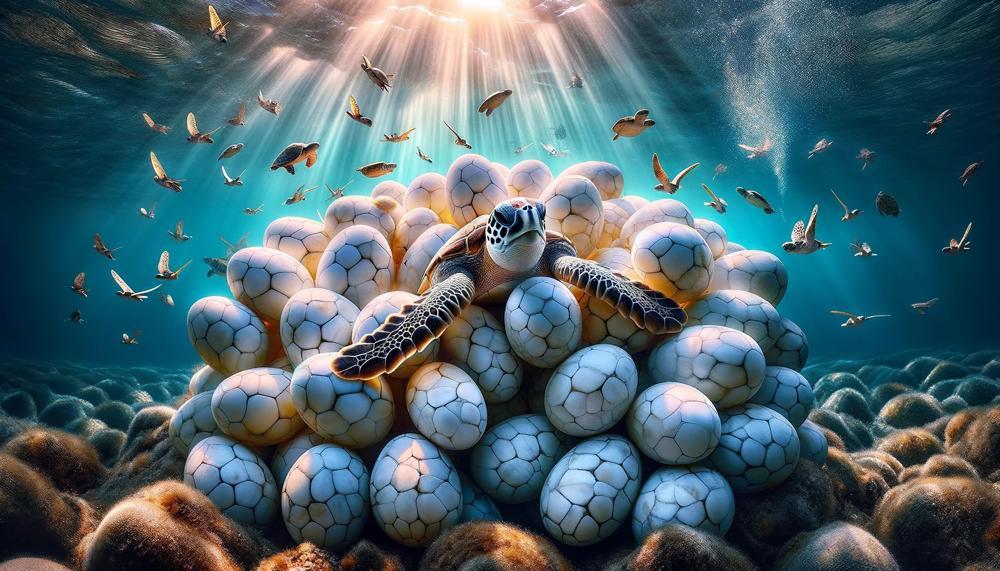Dive into the captivating world of sea turtles, these ancient mariners of the ocean, and discover one of the most fascinating aspects of their life cycle: the egg-laying process.
As creatures that have navigated the earth’s oceans for millions of years, sea turtles possess unique behaviors that contribute to the delicate balance of marine ecosystems.
Among these behaviors, the nesting and egg-laying ritual is a spectacle of nature that combines the struggle for survival with the beauty of life’s continuance.
In this article, we’ll explore:
- The Astonishing Number of Eggs: Delve into the specifics of how many eggs sea turtles lay, a figure that may surprise you.
- Species Variation: Understand how this number can vary significantly across different species of sea turtles.
- The Journey of Survival: From laying to hatching, discover the incredible journey of sea turtle eggs and the challenges they face.
- Conservation Significance: Learn why the egg-laying habits of sea turtles are vital for their survival and what they tell us about the health of our oceans.
Prepare to be engrossed in a story of resilience and wonder, as we shed light on the pivotal role that egg-laying plays in the lifecycle of sea turtles. This exploration not only aims to inform but to inspire action towards the conservation of these magnificent creatures and their habitats.
Join us as we uncover the secrets buried in the sand and the critical efforts needed to ensure that sea turtles continue to grace our oceans for generations to come.
Contents
- 1 Biological Reasons
- 2 External Factors
- 3 Climate change
- 4 Related Questions
- 4.1 Q: How does the temperature of the sand affect sea turtle hatchlings?
- 4.2 Q: Can human activities on beaches impact sea turtle nesting?
- 4.3 Q: How can people help protect sea turtle nesting sites?
- 4.4 Q: Are there any specific threats to sea turtle eggs and hatchlings?
- 4.5 Q: How long does it typically take for sea turtle eggs to hatch?
- 5 Conclusion
Biological Reasons
Sea turtles are remarkable for their prodigious egg-laying, a trait pivotal for their survival amidst the high mortality rates of their hatchlings. This strategy ensures that at least a few from the multitude will brave the odds to adulthood.
| Survival Mechanism | With a stark 1 in 1000 chance of hatchling survival, laying numerous eggs boosts the likelihood of offspring reaching maturity. |
| Longevity and Reproductive Cycle | Given their extended lifespan, up to 80 years, and late sexual maturity, maximizing offspring during each nesting is crucial. |
| Species-Specific Clutch Sizes | Varying by species, the clutch size can range extensively, e.g., leatherbacks lay up to 100 eggs, while green sea turtles can lay around 100-200 eggs. |
| Energy Conservation | The nesting process is arduous; laying many eggs at once minimizes the female’s land visits, conserving her energy. |
External Factors

Climate change and pollution undeniably influence the number of eggs sea turtles lay, with rising temperatures and the contamination of their natural habitats playing a significant role.
Sea turtles, creatures of habit and tradition, find themselves in an ever-changing world where their reproductive strategies are being tested.
Impact of Rising Temperatures
Increased temperatures, both in the air and the sea, affect sea turtle nesting habits and hatchling sex ratios. Sea turtles are temperature-dependent sex determination (TSD) species, meaning the temperature of the sand where eggs are incubated determines the sex of the offspring.
Warmer sands tend to produce more females, while cooler sands produce more males. With the globe warming, there’s an imbalance in sex ratios, which could have long-term effects on sea turtle populations and their ability to reproduce effectively.
Sea Level Rise and Nesting Sites
As sea levels rise, nesting beaches shrink, reducing the available space for sea turtles to lay their eggs. Flooding of nests becomes more common, drowning eggs or leading to lower hatching success rates.
This physical loss of habitat forces turtles to seek new nesting sites, which are often not ideal and can further decrease the number of successful hatchlings.
Pollution’s Direct and Indirect Effects
Pollution, including plastic waste and chemical runoff, poses both direct and indirect threats to sea turtles. Ingestion of or entanglement in plastic can lead to injuries or death in adult turtles, potentially reducing the number of eggs laid.
Chemical pollutants can alter the chemical composition of the sand and surrounding waters, affecting egg development and hatchling survival.
Solutions and Measures
Protecting nesting sites and implementing stricter environmental regulations are crucial steps toward mitigating these threats.
Public education on sustainable living practices also plays a key role in reducing pollution and helping to stabilize climate change effects.
| Factor | Impact on Sea Turtles | Potential Solutions |
| Rising Temperatures | Skewed sex ratios, altered nesting habits | Shade covers over nests, climate change mitigation |
| Sea Level Rise | Flooding of nests, loss of nesting beaches | Beach restoration, protective barriers |
| Pollution | Decreased hatchling survival, adult mortality | Reduce plastic use, improve waste management |
So, the battle against climate change and pollution is critical for the survival of sea turtles. Each of us plays a part in this struggle, through actions as simple as reducing plastic usage to advocating for policies that protect our planet.
Climate change
Climate change significantly impacts the nesting habits and egg production of sea turtles, a phenomenon meticulously examined by Mariana Fuentes and her team at Florida State University.
Their study, published in the journal Regional Environmental Change, highlights a challenging future for these creatures, particularly loggerhead, green, and leatherback turtles, with a projected decline in suitable nesting areas due to a mix of rising sea levels, escalating coastal development, and the quickened pace of climate change.
| Species | Impact by 2050 | Geographical Areas Affected |
| Loggerhead Turtles | ~10% decrease in suitable nesting areas | Florida, South Carolina, North Carolina |
| Green Turtles | ~7% decrease along the U.S. East Coast; some areas see improvement | Southwest Florida |
| Leatherback Turtles | No significant change in suitable nesting areas | Not specifically mentioned |
This shift, sparked by climate alteration, could submerge up to 80% of current habitats that possess a climate conducive to egg incubation. On the flip side, rising sea levels might also forge new beaches, potentially earmarking them as future nesting sites, providing they remain untouched by the claws of coastal development.
The research underscores the resilience of sea turtles, creatures that have braved past climate shifts. Yet, the current velocity of environmental change coupled with rampant coastal development poses a formidable barrier to their adaptation.
In regions like North Carolina and South Carolina, optimal nesting habitats are projected, thanks to their lower risk from sea-level rise and minimal housing growth. This silver lining suggests a ray of hope, accentuated by the implementation of management strategies like turtle-friendly lighting and the removal of beach debris, which aim to curtail further impacts from human activity on these majestic beings.
The crux of this situation lies in the intersection of climate change, sea-level rise, and human expansion, painting a complex tableau for the future of sea turtle nesting.
Related Questions
Q: How does the temperature of the sand affect sea turtle hatchlings?
A: The temperature of the sand influences the sex of sea turtle hatchlings. Warmer sands generally result in a higher number of female hatchlings, while cooler sands produce more males. This temperature-dependent sex determination is crucial for maintaining the population balance.
Q: Can human activities on beaches impact sea turtle nesting?
A: Absolutely. Activities such as coastal development, lighting near beaches, and the presence of trash can deter female turtles from nesting. They require dark, quiet beaches to lay their eggs. Excessive light can disorient hatchlings, leading them away from the sea.
Q: How can people help protect sea turtle nesting sites?
A: People can help by keeping beaches clean, reducing light pollution during the nesting season, and supporting local conservation initiatives. Participating in beach clean-ups and respecting wildlife guidelines also contribute to the protection of these crucial habitats.
Q: Are there any specific threats to sea turtle eggs and hatchlings?
A: Yes, there are numerous threats including predation by animals like raccoons, birds, and crabs. Human-induced threats include poaching and the accidental crushing of nests by vehicles or beachgoers. Climate change also poses a threat by increasing sand temperatures, which can lead to skewed sex ratios or egg mortality.
Q: How long does it typically take for sea turtle eggs to hatch?
A: Sea turtle eggs generally hatch after about 60 days of incubation. This period can vary slightly among different species and environmental conditions.
Conclusion
With their egg-laying ceremony, sea turtles carry out one of the most fascinating rituals in the grand dance of nature, creating a spell of wonder over the sands that will eventually cradle their species’ future. These ancient seafarers, who have spent millions of years traversing the expanse of the seas, realize that nesting is a delicate art.
To increase the tiny chances of hatchling survival, they lay an incredible number of eggs. The quantity of eggs, which varies from 50 to 200 depending on the species, highlights the variety of these organisms as well as the sheer will of these animals to persevere in the face of natural adversities and dangers brought about by humans.
This narrative of perseverance and survival, which traverses the trip from laying to hatching while overcoming obstacles like pollution, climate change, and habitat loss, is more than simply a statistical story. The paper emphasizes the complicated problem that increasing temperatures and shifting sea levels pose to conservation efforts by affecting the sex ratio and nesting behaviors.
Discovering the fascinating world of sea turtles serves as a reminder of the vital role that each of us plays in this intricate web of life. Given the ever-changing environment and the invasion of humans, the future of these ancient species depends on collaborative conservation efforts.
The narrative around the laying of sea turtle eggs serves as a powerful reminder of the beauty of life’s persistence and our duty to preserve it, from defending nesting beaches to addressing the more general problems associated with climate change.






